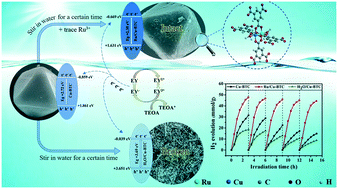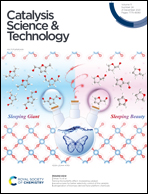Enhanced stability and activity of Cu–BTC by trace Ru3+ substitution in water photolysis for hydrogen evolution†
Abstract
Constructing stable, efficient and cost-effective cocatalysts is of great significance for photocatalytic H2 evolution in a dye-sensitization system. Herein, trace Ru-substituted metal–organic framework (MOF) Ru/Cu–BTC (0.44 wt%) was utilized in a photocatalytic water-splitting reaction for H2 production, in which the uniformly dispersed metal nodes with high atom-utilization efficiency could act as a cost-effective cocatalyst. Interestingly, Ru/Cu–BTC not only improved the stability in water, but also exhibited about 50% enhanced photocatalytic H2 evolution activity (15.815 mmol g−1 h−1) compared with the original Cu–BTC (10.514 mmol g−1 h−1). Meanwhile, the photoluminescence (PL) and cyclic voltammetry (CV) demonstrated that the main function of Ru3+ substitution for some uniformly dispersed Cu nodes in Cu–BTC is to improve the transfer efficiency of photogenerated carriers, so as to enhance the photocatalytic activity. Therefore, the decoration of uniformly dispersed metal nodes with heteroatom dopants in original MOFs could be an available strategy to adjust the partial structure of the metal cluster in MOFs, resulting in the more stable and cost-effective cocatalysts for photocatalytic H2 evolution.



 Please wait while we load your content...
Please wait while we load your content...